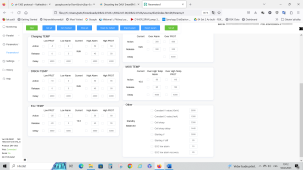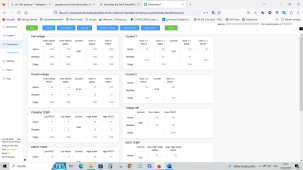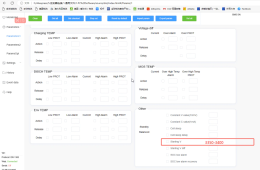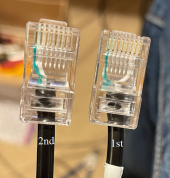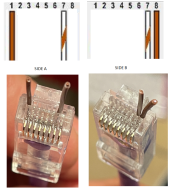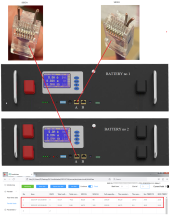I have two LiFePO4 48V 100Ah 5120Wh from AliExpress connected to Solis RHI-3K-48ES-5G 3kW
First, I bought one battery and six months later I bought second battery.
First battery came with Ver: DR-SAIENSI01 16S100 -V1.0.3T1_G
Second battery came with Ver: DR-SNS09 16S100JC11-V1.2.1T3
First battery had different set of cables in COM RJ45 head than second battery.
View attachment 156753
Also, first battery works on baud rate: 19200
Where, second battery works on baud rate: 9600
---To fix baud rate (to have both batteries on 9600), I installed .bin config on first battery.
#Battery 1:
Ver: DR-SAIENSI01 16S100 -V1.0.3T1_G (before .bin upgrade)
Ver: DR-DR01 16S100JC03-V2.0.0T1_V (after .bin upgrade)
Product Info: 2.2
Hardware model: T1_V
Product model: DR01
Project code: 16S100JC03
Software version: 2.0.0
Boot version: 1.1
#Battery 2:
Ver: DR-SNS09 16S100JC11-V1.2.1T3
Product Info: 2.2
Hardware model: T3
Product model: SNS09
Project code: 16S100JC03
Software version: 1.2.1
Boot version: 2.2
Please find attached .bin upgrade file: DR-DR01 16S100JC03-V2.0.0T1_V.7z
Application which I used to connect was: DR22.07.06
DR22.04.13 – did not work for me (was not able to see any COM ports in my laptop)
Also attached.
---To connect two batteries I made custom cable (normal computer ethernet cable did not work for me):
View attachment 156755
Laptop with DR_App connected to Battery_1
Battery DIP settings:
Battery_1 DIP 1-6 OFF
Battery_2 DIP 1 ON, DIP 2-6 OFF
In my case, custom RJ45 cable work only in one way. RJ45 Side_A connected to second battery, Side_B connected to first battery.
View attachment 156756
Inverter cannot work with DR_App at the same time.
Inverter: Solis RHI-3K-48ES-5G 3kW connected to Battery_1
Solis battery selection: Pylon LV (Pylontech)
Battery_1 DIP 1-5: OFF, DIP 6: ON
Battery_2 DIP 1: ON, DIP 2-6: OFF
The result of two batteries in Solis inverter:
If your 1st battery is charged at 100%
your 2nd battery is charged at 50%
Inverter will see it as: 75%



